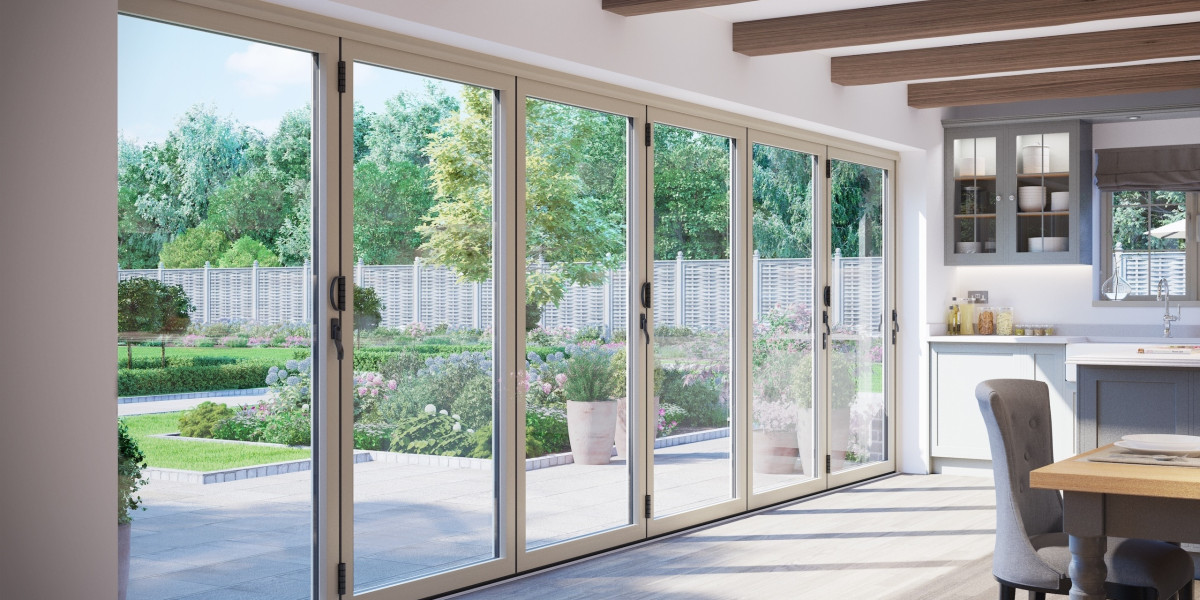
Bifold Door Repair: A Comprehensive Guide to Fixing Common Issues
bifold door handle repair doors, likewise understood as folding doors, are a popular option for property owners looking to make the most of area and develop smooth shifts in between spaces or indoor and outside living areas. Their sophisticated, space-saving design permits large openings without the swing area needed by conventional hinged doors. From closets and pantries to patio areas and space dividers, bifold doors use versatility and aesthetic appeal. Nevertheless, like any mechanical component in a home, bifold doors can experience wear and tear gradually, leading to various functional problems. Thankfully, numerous common bifold door problems are workable with some standard DIY skills and the right guidance.
This article functions as an extensive guide to understanding and resolving common bifold door repairs. We will check out typical concerns, equip you with the required tools and understanding, and walk you through step-by-step repair procedures. By comprehending the mechanics of bifold doors and discovering fundamental repair strategies, homeowners can extend the life-span of their doors and avoid pricey expert service calls.
Understanding Common Bifold Door Problems
Before diving into repairs, it's essential to determine the root cause of the problem. Bifold doors, while reasonably basic in design, count on numerous elements working in harmony. When one part breakdowns, it can affect the entire system. Here are a few of the most frequent issues house owners come across with bifold doors:
- Hanging or Sticking Doors: This is maybe the most typical problem. Doors might get stuck while opening or closing, require excessive force to move, or scrape against the frame or flooring. This can be triggered by misaligned hinges, deformed doors, or problems with the track and roller system.
- Misaligned Doors: Even when closed, bifold doors must sit flush and lined up. Misalignment can manifest as gaps between door panels, unequal spacing from the frame, or an inability to lock effectively. This can arise from loose hinges, distorted doors, or moved tracks.
- Damaged or Broken Hardware: The rollers, hinges, rotates, and tracks are the workhorses of a bifold door system. With time and with regular usage, these elements can use out, break, or become damaged. Broken rollers can avoid smooth moving, while harmed hinges can trigger sticking and misalignment. Harmed tracks can block roller movement and cause jerky operation.
- Loose Screws and Fittings: Vibrations from regular use can loosen up screws and fittings that hold the hinges, tracks, and other hardware in place. Loose elements can lead to instability, misalignment, and noisy operation.
- Deformed Doors: Exposure to moisture and temperature level variations can cause wood bifold door fixes doors to warp. Distorted doors can be hard to close correctly, may rub versus the frame, and can create gaps.
Important Tools and Materials for Bifold Door Repair
Having the right tools and products on hand will make the repair process considerably smoother and more efficient. Here's a list of typical items you might need:
- Screwdrivers: A set of Phillips head and flathead screwdrivers of numerous sizes is important for tightening up and loosening screws.
- Drill/Driver: For more persistent screws or for setting up brand-new hardware, a drill/driver can be indispensable. Guarantee you have a variety of drill bits and screwdriver bits.
- Hammer: A hammer can be useful for gently tapping parts into location or for getting rid of stubborn pins.
- Pliers: Pliers work for grasping little parts, bending metal parts, and eliminating pins.
- Level: A level is important for guaranteeing doors are properly aligned vertically and horizontally.
- Measuring tape: For precise measurements when replacing parts or changing door positions.
- Wood Shims: Shims are slices of wood utilized for leveling and aligning doors within the frame.
- Lube (Silicone Spray or Dry Lube): Lubricant can considerably improve the smooth operation of rollers and hinges.
- Replacement Rollers, Hinges, and Tracks: Depending on the concern, you might require to purchase replacement parts. It's frequently practical to identify the producer and model of your bifold doors to guarantee you get compatible replacements.
- Wood Filler or Epoxy (for wood doors): For repairing small damage to wood doors, such as broken corners or screw holes.
- Safety Glasses and Gloves: Always prioritize security when carrying out DIY projects.
Step-by-Step Bifold Door Repair Guide
Now, let's look into the practical actions for repairing typical bifold door problems:
1. Dealing With Hanging or Sticking Doors:
- Inspection: Begin by thoroughly observing where the door is sticking or hanging. Is it rubbing against the top, bottom, or side of the frame?
- Lubrication: Often, an easy lubrication of the rollers and track can solve sticking concerns. Apply silicone spray or dry lube to all moving parts, consisting of rollers, hinges, and the leading and bottom tracks. Open and close the door several times to distribute the lubricant.
- Hinge Adjustment: If lubrication doesn't fix the issue, examine the hinges. Loose hinges can trigger doors to sag. Tighten any loose hinge screws. If the screws are stripped, you might need to use longer screws or wood filler in the screw holes before re-screwing.
- Track Adjustment: In some cases, the track itself may be somewhat misaligned. Examine if the track is securely fastened to the frame. If it's loose, tighten the screws. Minor track misalignment can sometimes be fixed by carefully tapping the track into place with a hammer and block of wood.
- Door Warping: If the door is distorted, small warping may be attended to by carefully straightening it using clamps and weights. However, seriously deformed doors may require to be replaced.
2. Repairing Misaligned Doors:
- Hinge Adjustment (Lateral Alignment): Misalignment can often be remedied by adjusting the hinges. Loosen up the hinge screws slightly and carefully shift the door panel left or right to attain better positioning. Retighten the screws when aligned.
- Shims (Vertical Alignment): If the door is unequal vertically, you can utilize shims. Open the door and place shims behind the depend upon the lower panel to raise it or behind the hinges on the upper panel to reduce it. Try out shim positioning and thickness up until the doors are aligned, then tighten up the hinge screws securely.
- Leveling the Frame: In rare cases, the door frame itself may be out of level. Use a level to check the frame. If it's not level, you may require to change the frame itself, which can be a more complex job and might require expert help.
3. Changing Damaged Hardware (Rollers, Hinges, Tracks):
- Roller Replacement:
- Open the bifold door and find the damaged roller.
- Depending on the style, you might require to remove a keeping clip or screw to launch the old roller.
- Thoroughly get rid of the old roller.
- Insert the brand-new roller, guaranteeing it is correctly seated and secured.
- Check the door operation.
- Hinge Replacement:
- Open the door and determine the harmed hinge.
- Eliminate the screws holding the hinge to both door panels and the frame.
- Eliminate the old hinge.
- Position the new hinge in the same location.
- Protect the new hinge with screws.
- Evaluate the door operation.
- Track Replacement: Replacing a track is a more involved procedure and is typically only needed if the track is severely harmed or bent.
- Get rid of the bifold doors from the track.
- Loosen the old track from the frame.
- Procedure and cut the brand-new track to the right length, if essential.
- Position the brand-new track and protect it to the frame with screws.
- Reinstall the bifold doors.
- Check the door operation.
4. Tightening Loose Screws and Fittings:
- Regular Inspection: Periodically check all screws and fittings on your bifold doors.
- Tightening up: Use a screwdriver to tighten up any loose screws.
- Stripped Screw Holes: If screws are consistently loosening or stripped, you can utilize wood filler (for wooden doors) or epoxy to repair the screw holes. Fill the hole, let it dry, pre-drill a pilot hole, and after that re-install the screw. Additionally, use a little longer or broader screws to get a better grip.
Routine Maintenance for Bifold Doors
Preventative upkeep is essential to extending the life of your bifold doors and lessening the need for repairs. Here are some important upkeep pointers:
- Regular Cleaning: Keep the tracks and rollers clean from dust, particles, and animal hair. Vacuum or wipe down tracks routinely.
- Lubrication: Lubricate rollers and hinges a minimum of twice a year or whenever you notice the doors beginning to stick or squeak.
- Inspect Hardware Periodically: Check for loose screws, used rollers, or harmed hinges during your regular home maintenance checks.
- Gentle Operation: Avoid slamming or requiring bifold doors. Operate them smoothly and carefully to avoid unneeded stress on the hardware.
When to Call a Professional
While lots of bifold door issues can be dealt with DIY, there are scenarios where it's best to call a professional handyman or door professional:
- Significant Door Warping: Severely distorted doors might be beyond DIY repair and need professional replacement.
- Complex Track Issues: If the track is substantially bent, damaged, or if you believe structural problems with the frame, professional expertise is recommended.
- Absence of DIY Experience: If you are uneasy with DIY repairs or lack the essential tools, seeking expert help is always a safe and sensible alternative.
- Time Constraints: If you are brief on time or choose to have the repair done rapidly and effectively, a specialist can handle the job.
Conclusion
Bifold doors are a valuable addition to any home, offering area efficiency and aesthetic appeal. Understanding their mechanics and typical problems empowers property owners to perform standard repairs and upkeep, guaranteeing their durability and smooth operation. By following the steps detailed in this guide, and with a little perseverance and the right tools, you can successfully attend to most bifold door issues and keep your doors working perfectly for many years to come. Keep in mind, routine upkeep and prompt attention to small issues can avoid bigger issues and conserve you money and time in the long run.
Regularly Asked Questions (FAQs) about Bifold Door Repair
Q: Why are my bifold doors sticking?A: Sticking bifold doors are typically brought on by absence of lubrication, misaligned hinges, or particles in the tracks and rollers.
Q: How typically should I lubricate bifold door rollers?A: It's recommended to lubricate bifold door rollers a minimum of twice a year or whenever you see the doors ending up being less smooth to run.
Q: Can I replace bifold door Hinge replacement door rollers myself?A: Yes, replacing bifold door rollers is a relatively simple DIY job. Guarantee you buy compatible replacement rollers for your door type.
Q: My bifold doors are misaligned even when closed. How can I fix this?A: Misalignment can typically be fixed by adjusting the hinges. Attempt loosening hinge screws and gently moving door panels for much better positioning, or utilize shims behind hinges to adjust vertical alignment.
Q: What kind of lubricant is best for bifold door track adjustment door rollers?A: Silicone spray or dry lube are exceptional choices for bifold door rollers as they are less most likely to draw in dust and debris compared to oil-based lubes.
Q: When should I consider changing my bifold doors rather of fixing them?A: Consider changing quick bifold door repairs doors if they are significantly warped, extensively damaged, or if the cost of repairs surpasses the expense of new doors, particularly if they are old and broken.








